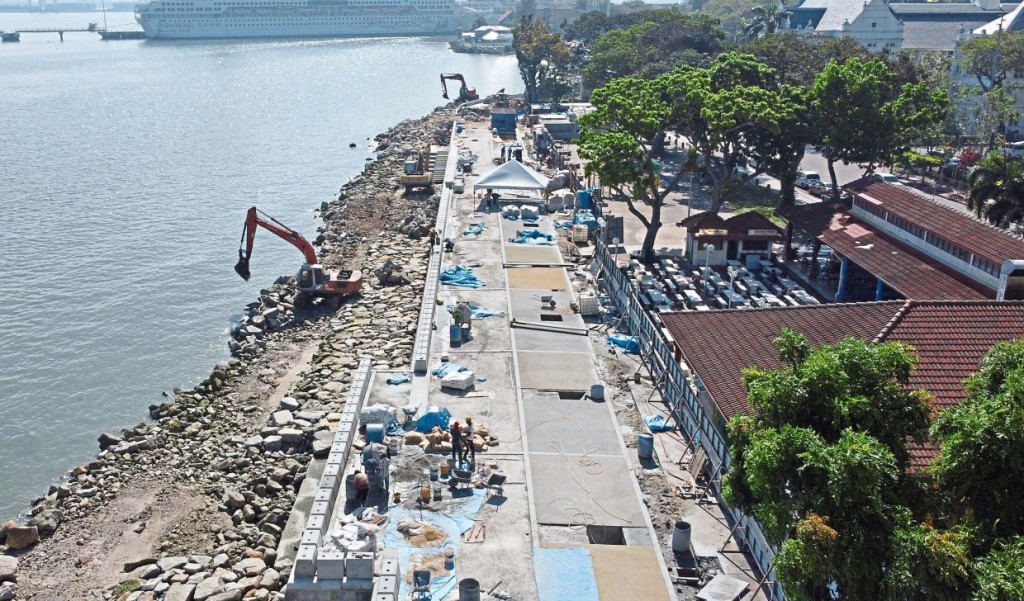Esplanade seawall upgrading is expected to complete by end next month

Works on the RM14mil Esplanade seawall upgrading are on schedule, with completion expected at the end of April.
Outlining the project works, Perunding YAA Sdn Bhd said it employed methods and construction materials that would “harmonise” with the qualities and heritage significance of the George Town World Unesco Heritage Site in Penang.
“The seawall will look simple in construction and relatively easy to maintain. It is also sufficiently traditional in appearance,” said its principal consultant Michael Yap.
“Most of the granite rocks used in the construction were quarried from nearby Penang Hill,” he added.
The seawall upgrading project involves a stretch of 460m from Medan Renong food court to the Royal Malaysian Naval Base.
It is one of 14 projects under the RM140mil North Seafront Masterplan that starts from Dewan Sri Pinang to Fort Cornwallis and the entrance to Swettenham Pier.
Yap said a terraced seawall near the Cenotaph Memorial was also being built, to bring the people closer to the sea.
“It is accessible during low tide and offers a direct view of the original seawall.
“Along the northwest section of the seawall, in front of the Medan Renong food court, there will be two stairways to give people direct access to the sea as well as the large boulders of the sloping revetment that are exposed during low tide,” he said.
Yap said an initial assessment of the seawall was carried out between December 2016 and January 2017 to evaluate the principal problems and general condition of the structure.
“The existing seawall in the area of study was built in varying sections and consisted of blocks of granite stones of different shapes and sizes.
“In some areas, brick masonry parapets were added at a later stage on top of the mass gravity wall to prevent wave running, splashing and overtopping of seawater.
“This form of seawall construction is common in this region.
“It is economical and an efficient form of sea defence, given that an exposed seafront in these coastal areas will be subject to considerable wave attack during rough sea conditions,” he elaborated.
Penang Island City Council (MBPP), which funded the project, said any infrastructure construction within a site that was rich in history, culture and heritage would present its own set of challenges and surprises.
MBPP secretary A. Rajendran said that among them were a number of social and traffic related issues such as temporary loss of public space during construction, the hoarding up of the food court, loss of parking spaces and partial rerouting of traffic.
“In addition, the project had to establish protective measures and the monitoring of possible damage to the historical buildings in the vicinity, such as the Royal Malaysian Navy building, City Hall and the Cenotaph Memorial.
“During the construction of this project, there was an unexpected discovery of five cannons and short range mortars dating back to the late 18th and early 19th centuries, as well as shells of detonated ammunition from various conflicts.
“The cannons have now been moved away from the site and are being restored by Universiti Sains Malaysia’s Archeology Department.
“The shells of the detonated bombs were found among the debris, which pointed to the war-time conflicts that occurred off the shores of George Town in the 20th century,” said Rajendran.
Penang local government committee chairman Jagdeep Singh Deo also did a site inspection of the project recently.
The project is supported by the George Town Conservation and Development Corporation (GTCDC), a partnership between the Penang government and Think City.
The corporation has been formed to spearhead the rejuvenation and restoration of select public assets in the heritage site.
It is meant to enhance the appeal and value of key monuments and public open spaces, and demonstrate the value of culture-based urban regeneration in creating a sustainable heritage city.
To date, among the 14 major initiatives completed are the restoration of Koh Seang Tatt Fountain Garden, improvements to Lebuh Light streetscape, upgrading of Esplanade field subsoil system and numerous planning documents produced to assist with the physical implementation.
Source: TheStar.com.my

